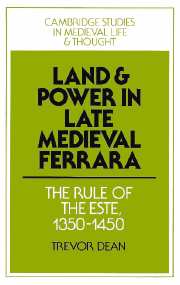Book contents
- Frontmatter
- Contents
- List of maps
- Preface
- List of abbreviations
- Note on sources
- Note on money, measurements and terms
- 1 Introduction
- 2 The Este patrimony
- 3 The Este vassals and their fiefs
- 4 Feudal tenure at Ferrara
- 5 Noble society at the centre
- 6 Noble society in the provinces
- Conclusion
- Appendices
- Bibliography
- Index
5 - Noble society at the centre
Published online by Cambridge University Press: 10 November 2009
- Frontmatter
- Contents
- List of maps
- Preface
- List of abbreviations
- Note on sources
- Note on money, measurements and terms
- 1 Introduction
- 2 The Este patrimony
- 3 The Este vassals and their fiefs
- 4 Feudal tenure at Ferrara
- 5 Noble society at the centre
- 6 Noble society in the provinces
- Conclusion
- Appendices
- Bibliography
- Index
Summary
Only in very few cases did the fiefs held by Ferrarese nobles of the Este form a major part of noble patrimonies. The pattern of noble landowning was extremely varied and Este fiefs were only one part of a complex structure of landownership. As we have seen, the chief churches of the city held extensive possessions in the contado which were in large part distributed among the nobility and citizens, to say nothing of the property of lesser monasteries and churches, which often fell into the control of important local families. The Este patrimony itself, as we have seen, was largely made up of church land. It is the purpose of this chapter to investigate the relationship between Este grants and families' other sources of wealth and social prestige.
THE ELEVATION OF NEW FAMILIES
It might be expected that Este grants would form a greater proportion of the landed possessions of ‘new’ and immigrant families than of the ancestral lands of the old nobility. In some families this was so, most conspicuously in the case of the Roberti, for whom there exists complete documentation of their acquisitions, in the form of a cartulary compiled in 1398–9 of documents running from 1363. This reveals that in the period from 1363 to 1392 the bulk of Roberti lands in the Ferrarese were held in fief of the marquises and that purchases of allodial land added only slightly to them.
- Type
- Chapter
- Information
- Land and Power in Late Medieval FerraraThe Rule of the Este, 1350-1450, pp. 134 - 149Publisher: Cambridge University PressPrint publication year: 1987



